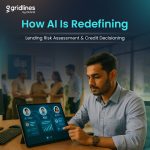In a world where credit is the fuel for growth, lenders walk a fine line. On one side lies opportunity — millions of potential borrowers waiting to be empowered. On the other lies risk — fraud, delinquency, and financial loss. The challenge is timeless: how to lend faster, safer, and smarter.
Until recently, credit decisions were driven by human intuition and static data points — a few numbers on a report, a declared income, a scanned document. But the lending landscape has changed dramatically. Borrowers are more diverse, businesses are more dynamic, and data is more abundant than ever before.
Artificial Intelligence (AI) has entered this equation as a quiet but transformative force. It’s not just automating what humans used to do — it’s rethinking what’s possible. By bringing intelligence to verification, analysis, and decision-making, AI is turning credit assessment into a science powered by data and speed.
Why Traditional Credit Decisioning Is Falling Short
Conventional lending systems were built around simplicity: gather a few documents, check a credit bureau score, and approve or reject. But this model has begun to crack under modern realities.
Borrowers today — especially small business owners, gig workers, and first-time credit seekers — often don’t fit neatly into old templates. They may have irregular incomes, digital footprints instead of paper trails, and financial patterns that don’t show up in legacy systems.
For lenders, this means risk is harder to quantify, fraud is harder to detect, and good customers sometimes get left out because the system can’t “see” them clearly.
At the same time, the pressure for faster approvals has never been higher. Fintechs and digital lenders are competing on turnaround time. What used to take days now needs to happen in minutes. Manual underwriting and back-office checks simply can’t keep up.
This is where AI steps in — not to replace human judgment, but to amplify it.
The AI Advantage: Lending That Learns and Adapts
AI thrives where there’s data, complexity, and the need for speed — and lending has all three. Instead of treating risk as a static number, AI models look at risk as a moving picture: a combination of identity, behaviour, and intent that evolves over time.
Here’s how that transformation unfolds in practice.
1. Identity Verification That’s Instant and Authentic
The first step in any loan journey is identity — knowing who’s asking for credit. Traditionally, lenders relied on physical documents and manual checks. Today, with AI-enabled national identity verification through platforms like DigiLocker, the process has become instant, paperless, and tamper-proof.
AI models analyze data consistency across IDs, detect forgeries, and even flag synthetic identities that don’t exist in real life but look valid on paper.
For example, a synthetic identity may mix real and fake data — a genuine mobile number tied to a fabricated PAN or mismatched name. AI systems can detect these inconsistencies far faster and more accurately than human verifiers.
The result: less friction for genuine borrowers and fewer opportunities for fraudsters to slip through.
2. Employment and Income Validation That Goes Beyond Payslips
Income verification used to depend on a few static proofs: a salary slip, a tax return, or a self-declaration. But AI goes deeper.
By analysing data from EPFO records and bank statement analysers, AI systems can understand income trends over time — not just what someone earns, but how consistently they earn it.
For salaried borrowers, this means checking employment continuity, contribution patterns, and income growth.
For self-employed individuals, it means parsing hundreds of bank transactions to assess cash flow health, seasonality, and spending habits.
The model doesn’t judge by one month’s income; it studies behaviour — how regularly funds are credited, how expenses fluctuate, and how often balances drop below a certain level.
That’s the kind of detail that turns guesswork into precision.
3. Business Validation for Smarter SME Lending
In business lending, verifying an enterprise’s legitimacy and financial standing is crucial. AI simplifies this through automated business validation using GSTIN, Udyam registration, and MCA data.
Each of these sources reveals a layer of truth: GST data shows turnover consistency, Udyam reflects small business registration, and MCA filings provide ownership and compliance history.
When AI analyses these collectively, it can identify red flags like sudden turnover drops, multiple ownership changes, or inactive registrations.
Instead of manually combing through paperwork, the system delivers a real-time confidence score — allowing lenders to make faster, evidence-backed credit decisions for small and medium enterprises that were traditionally hard to underwrite.
4. Alternate Data Scoring: The Hidden Layer of Creditworthiness
What happens when a borrower has little or no credit history? This is where alternate data becomes the hero.
AI systems now incorporate non-traditional signals such as telecom usage, utility payments, vehicle ownership (RC), and LPG refill patterns.
Someone who pays their phone and electricity bills on time, for instance, is statistically more likely to repay a loan.
AI doesn’t just collect this data — it learns from it. It studies patterns across millions of users, identifying subtle correlations between daily financial discipline and credit reliability.
This alternative data scoring opens credit access for those who were previously invisible to traditional credit bureaus — gig workers, rural borrowers, and micro-entrepreneurs.
5. Fraud Detection That Thinks Like a Fraudster
Fraudsters don’t wait for technology to catch up — they evolve. Fake identities, duplicate applications, device sharing, and coordinated fraud rings are now common in the lending ecosystem.
AI counters this by learning behavioural fingerprints. It spots when multiple applications come from the same IP address, when device IDs overlap, or when an identity pattern doesn’t fit known population data.
It can also detect “multi-app behaviour” — where the same applicant applies simultaneously across multiple lenders, hoping one slips through.
This intelligent fraud detection doesn’t just rely on predefined rules; it adapts with every new data point, making it harder for bad actors to outsmart the system.
The Real Impact: Faster, Smarter, and Safer Lending
The outcomes of AI-driven risk assessment are tangible and transformative:
Faster Approvals
By automating verification and scoring, lenders can move from hours or days to real-time decisioning. Borrowers experience instant gratification; lenders gain higher conversion rates and reduced processing costs.
Higher Risk Accuracy
AI models analyze thousands of data variables simultaneously, identifying risk factors that humans might miss. This improves accuracy in predicting defaults or delinquencies — allowing for better portfolio performance and healthier loan books.
Reduced Delinquency
Smarter screening means fewer high-risk borrowers make it through. AI-based early warning systems can also monitor borrower behaviour post-disbursal, flagging changes that suggest potential distress before a payment is missed.
Financial Inclusion
Perhaps the most underrated impact — AI makes lending fairer. By considering alternate data, it gives a voice to the underbanked and the new-to-credit, opening access to formal finance for millions who were previously excluded.
Inside the AI Decisioning Engine
Let’s imagine what happens under the hood when a loan application arrives:
- Identity Layer:
The system authenticates identity using DigiLocker, matching names, numbers, and photos. AI instantly flags mismatches or duplicate IDs. - Data Enrichment:
Employment data is fetched from EPFO, income patterns are drawn from bank statements, and business data is verified through GSTIN or MCA databases. - Alternate Data Scoring:
AI aggregates utility, telecom, and behavioural data to understand spending regularity and financial discipline. - Fraud Analysis:
The engine checks for device overlaps, velocity of applications, and anomalies that indicate synthetic or shared identities. - Composite Scoring:
All this data feeds into a unified risk model that generates a dynamic credit score, not just based on past credit history but on current reliability and real-world signals. - Decision Output:
The model produces an outcome — approve, review, or decline — supported by a rationale that’s explainable and auditable.
This is how AI transforms a chaotic mix of data points into a coherent, actionable decision — all in the time it takes to refresh a web page.
The Challenges That Come With Intelligence
Despite the promise, implementing AI in lending isn’t without its challenges.
- Data Quality: AI is only as good as the data it learns from. Inconsistent or incomplete records can skew results.
- Model Transparency: Regulators and lenders alike need to understand why a decision was made. This requires explainable models rather than opaque algorithms.
- Bias and Fairness: AI must be trained on diverse datasets to avoid discriminating against specific regions or demographics.
- Continuous Learning: Borrower behaviour evolves, and models must be retrained periodically to stay accurate.
- Human Oversight: AI can flag anomalies, but humans must interpret them in context. The best systems combine machine efficiency with human judgment.
Addressing these challenges ensures that AI remains a tool for empowerment, not exclusion.
A More Inclusive Future for Credit
The traditional credit ecosystem worked well for people with stable jobs, clear documentation, and long financial histories. But it left behind millions — freelancers, small business owners, farmers, and informal workers.
AI is rewriting that story. By reading signals from employment data, bank activity, digital payments, and even utility usage, lenders can now extend credit to those who deserve it but were previously invisible.
This is especially transformative in a country like India, where digital public infrastructure — from PAN to DigiLocker to UPI — has laid the groundwork for responsible, data-driven credit growth.
When combined with AI, these systems can unlock unprecedented inclusion — not by lowering standards, but by broadening understanding.
Why AI Doesn’t Replace the Human Touch
It’s important to remember that lending is still a human business. Behind every loan application is a story — a business dream, a medical emergency, a family milestone.
AI can process the facts, but empathy and judgment remain human strengths.
The most successful lenders will be those who let AI handle the heavy lifting — the data, the risk, the verification — while humans focus on building relationships and making nuanced decisions when the model hesitates.
In this sense, AI isn’t replacing the credit officer; it’s giving them superpowers.
The Road Ahead
AI-driven lending is still evolving. Future systems will go beyond decisioning to continuous risk monitoring — watching live transaction data to predict financial stress before it happens.
Generative AI will start summarizing borrower profiles, drafting credit memos, and even interacting with customers conversationally. Fraud models will learn faster, alternative data will deepen, and regulations will mature to keep the ecosystem transparent.
The direction is clear: risk assessment is moving from reactive to predictive, from manual to intelligent, and from exclusionary to inclusive.
Final Thoughts
AI has changed the DNA of lending. What once took hours of manual verification and subjective judgment can now happen in seconds — with greater precision, fairness, and reach.
By unifying identity verification, employment and income validation, business authenticity checks, alternate data scoring, and fraud detection, lenders can finally achieve what the industry has long pursued:
- Faster approvals without cutting corners
- Smarter decisions backed by real-world data
- Lower delinquency through proactive insight
In the end, AI doesn’t just make lending efficient — it makes it human again.
Because when technology helps lenders truly understand who they’re lending to, it transforms credit from a transaction into trust.
And trust, after all, is the real currency of lending.





Leave a Reply